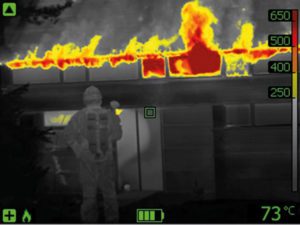 There’s no question that drone technology has progressed far beyond strictly recreational use. Drones are critical equipment in enterprises including agriculture, construction, inspections and insurance. The business case for these applications is strong – but drones equipped with high-powered thermographic equipment can do more than just save money, they’re saving lives.
There’s no question that drone technology has progressed far beyond strictly recreational use. Drones are critical equipment in enterprises including agriculture, construction, inspections and insurance. The business case for these applications is strong – but drones equipped with high-powered thermographic equipment can do more than just save money, they’re saving lives.
A report published earlier this year by drone manufacturer DJI said that more than 58 lives had been saved directly through the use of drone technology – and countless others when drones are used as an integral part of an emergency response. Drones have been instrumental in saving lives through search and rescue, emergency response, and firefighting.
Airborne, sophisticated imaging systems have been used for years to provide situational awareness to military or large civil operations – but drones provide a great way to get powerful imaging equipment in the air, quickly and cheaply. Thermographic equipment attached to a prosumer or commercial drone results in a life-saving tool for public sector work. In search and rescue operations, drones allow greater coverage of a search area – and thermography allows rescue teams to work through the night, significantly increasing the potential for success. Thermal imaging cameras give teams the power to “see in total darkness,” says FLIR, the global leader in thermographic imaging sensors. Added to that is the ability to discern figures difficult to find with traditional cameras even in daylight- like one stranded hiker lost against the backdrop of a snowy field. This capacity is one of several reasons that law enforcement organizations around the world are using drones.
Emergency response teams, first on the ground to cover natural and manmade disasters of all types, are also adopting drone technology quickly. Being able to evaluate a situation immediately and to identify victims stranded in the midst of debris caused by floods, fires, and earthquakes in the first few hours after a disaster hits makes a significant human impact. During the Chennai floods in India last year, dozens of people stranded on the roofs of their homes were identified by drone to be rescued by teams of workers traveling through the flooded city in boats. Drones are also being used to quickly re-establish communications networks, deliver emergency supplies, and plan for emergency transportation routes.
Firefighting may provide one of the most compelling applications for drones equipped with thermal imaging equipment. From New York City’s famous FDNY to volunteer departments in small towns around the country, fire departments are utilizing drone technology to save structures and victims, and minimize risk to firefighters. The aerial perspective through a thermal imaging camera allows teams to pinpoint hotspots, identify victims on the scene, and quickly establish a plan of attack. It provides a level of visibility in the midst of a fire that is impossible with the naked eye or traditional cameras. (You can see how a fire looks through the lens of one of these thermographic tools here – experiencing a firefighters view through dark and smoke.) Drones not only make firefighters more effective – they keep them safe.
Drone technology has brought the benefits of powerful imaging equipment to the skies – and put those tools in reach for teams of any size. As the adoption of drone technology spreads, so do the benefits: not just for big business, but for communities everywhere.
Alan is serial entrepreneur, active angel investor, and a drone enthusiast. He co-founded DRONELIFE.com to address the emerging commercial market for drones and drone technology. Prior to DRONELIFE.com, Alan co-founded Where.com, ThinkingScreen Media, and Nurse.com. Recently, Alan has co-founded Crowditz.com, a leader in Equity Crowdfunding Data, Analytics, and Insights. Alan can be reached at alan(at)dronelife.com







[…] the meantime, we’ll keep telling as many Drones for Good stories as we can come up with. We’ll keep writing about the cool technology, the economic […]